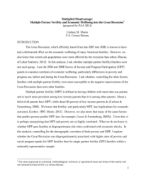
An official website of the United States government
Here’s how you know
Official websites use .gov
A .gov website belongs to an official government organization in the United States.
Secure .gov websites use HTTPS
A lock (
) or https:// means you’ve safely connected to the .gov website. Share sensitive information only on official, secure websites.
-
//
- Census.gov /
- Library /
- Census Working Papers /
- Multiplied Disadvantage: Multiple Partner Fertility
Multiplied Disadvantage: Multiple Partner Fertility and Economic Wellbeing into the Great Recession
Multiplied Disadvantage: Multiple Partner Fertility and Economic Wellbeing into the Great Recession
Introduction
The Great Recession, which officially lasted from late 2007 into 2009, is known to have had a detrimental effect on the economic wellbeing of many American families. However, we also know that certain sub-populations were more affected by the recession than others (Bureau of Labor Statistics, 2012). In this analysis, I ask whether multiple partner fertility families were one such group. I use the 2004 and 2008 Survey of Income and Program Participation (SIPP) panels to examine correlates of economic wellbeing, particularly differences in poverty and program use, before and during the Great Recession. I ask whether, controlling for other factors, families with multiple partner fertility were more susceptible to the negative repercussions of the Great Recession than were other families.
Multiple partner fertility (MPF) is defined as having children with more than one partner, and is much more prevalent among low-income parents than it is among other parents. About a third of all parents have MPF, while about 60 percent of low-income parents do (Carlson & Furstenberg, 2006). We know that fertility, and particularly MPF, has implications for economic outcomes (Lichter, 1997; Monte, 2011). However, we also know that many of the same factors that predict poverty predict MPF (see, for example, Guzzo & Furstenberg, 2007b). Given this, it is perhaps unsurprising that MPF and poverty are so highly correlated. What we do not know is whether MPF puts families at disproportionate risk when confronted with economic shocks. In this analysis, controlling for the demographic correlates of both poverty and MPF, I explore whether the Great Recession was disproportionately associated with higher rates of poverty and social program uptake for MPF families than for single partner fertility (SPF) families within a nationally representative sample.
Share
Related Information
WORKING PAPER
Fertility Working PapersSome content on this site is available in several different electronic formats. Some of the files may require a plug-in or additional software to view.
 Yes
Yes
 No
NoComments or suggestions?


Top

